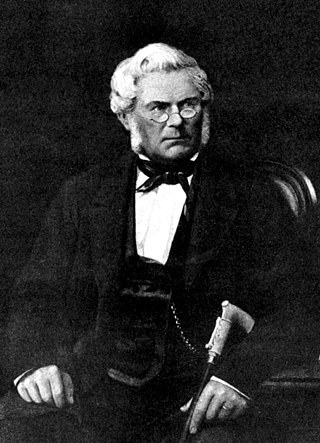Top Qs
Timeline
Chat
Perspective
Immanuel Nobel
Swedish architect, engineer, inventor, and industrialist (1801–1872) From Wikipedia, the free encyclopedia
Remove ads
Immanuel Nobel the Younger (/noʊˈbɛl/ noh-BEL, Swedish: [nʊˈbɛlː]; 24 March 1801 – 3 September 1872) was a Swedish engineer, architect, inventor and industrialist. He was the inventor of the rotary lathe used in plywood manufacturing and also designed and worked on several inventions such as an improved underwater mine used in the Crimean war.[1] He was a member of the Nobel family and the father of Robert Nobel, Ludvig Nobel, Alfred Nobel and Emil Oskar Nobel. In 1827, he married the children's mother, Andriette Ahlsell.[2][3] Nobel also often experimented with nitroglycerin with his sons, one of whom, Emil, died from an explosion at his father's factory Heleneborg in Stockholm in 1864. Nobel suffered a stroke and died on 3 September 1872.
Remove ads
Biography
Summarize
Perspective
Early life and education
As Nobel's family could not afford formal education, his father taught him how to read and write. At the age of 14, Nobel became a sailor, then after his return to Sweden in 1819 when he was 18, he went into the building industry.[1] Sometime between 1822 and 1825, Nobel attended lessons at the Swedish University of Agricultural Science's engineering college in Stockholm. In 1827, he married Andriette Ahlsell, of whose children eight survived infancy.[4]
St. Petersburg and the Crimean War
In 1833, Nobel became bankrupt after failing to start business in his native Sweden. After a few years,[when?] Nobel, without his family, moved first to Finland, and then to St. Petersburg, Russia. Here he was attached to the Evangelical Lutheran Church of Saint Katarina along with other Swedes such as Johan Patrik Ljungström, with whom he may have collaborated.[5] Nobel started a mechanical workshop, Fonderies et Ateliers Mécaniques Nobel Fils, making military equipment for the Russian army.[1] During the Crimean War, Nobel worked on improving naval mines that Nicholas I took interest in using in the war.[6] During this time, Nobel also invented several machine tools and a system for central heating.[1] After the end of the Crimean War in 1856, and with a consequent cutting of the military budget by the new Tsar Alexander II, his company began facing financial difficulties.[6][1] Nobel appointed his son Ludvig as director of the business and returned to Sweden with his wife and with two of his other sons Alfred and Emil.
In 1862, Immanuel's firm was sold by his creditors.[6]
Return to Sweden and death
Upon Nobel's return to Sweden, he and his sons began experimenting with Nitroglycerin. An explosion at nitroglycerin factory in Heleneborg, Sweden[7] on 3 September 1864 killed his son Emil and several others. Shortly after the explosion,[when?] Nobel suffered a stroke and was confined to his bed during this time he wrote the paper ”Försök till anskaffande af arbetsförtjenst till förekommande af den nu, genom brist deraf tvungna utvandringsfebern", published after his death in 1870.[8][4] Nobel would not recover from the stroke. He died on 3 September 1872.[1] Nobel's son Alfred would continue his work with nitroglycerin going on to invent dynamite, after his death in 1896 he gave his to establish the Nobel Prizes and the Nobel Foundation, which manages them in his family's namesake, in 1900 and 1901 respectively.[9][10]
Remove ads
References
Sources
External links
Wikiwand - on
Seamless Wikipedia browsing. On steroids.
Remove ads

